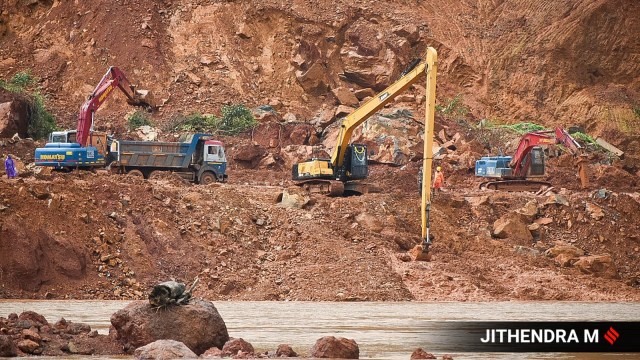Stay updated with the latest - Click here to follow us on Instagram
Unscientific work by NHAI led to Shirur landslide: Geological Survey of India report
In its preliminary report submitted to the NHAI and state government, a team from the Geological Survey of India (GSI) has, while assessing the landslide, pointed to the “unscientific” work done by the NHAI on this stretch.
 The landslide site on NH-66 in Ankola. (Express photos by Jithendra M)
The landslide site on NH-66 in Ankola. (Express photos by Jithendra M)A preliminary report by a technical team looking into the causes of the July 16 landslide in coastal Karnataka’s Uttara Kannada district has listed “unscientific” construction of National Highway (NH) 66 by the National Highway Authority of India (NHAI), combined with heavy rainfall in a short span of time, among factors responsible for the disaster.
At 8.30 am on July 16, a massive landslide brought down a torrent of mud and debris at Shirur village in Akola, destroying the Karwar-Mangaluru portion of the 1,640-km highway, which connects Maharashtra’s Panvel with Kanyakumari in Tamil Nadu. Besides damage to the highway, four houses and two high-tension power transmission towers at Akola were destroyed, and a tea stall and two trucks got washed away in the landslide. Eight bodies have been recovered so far and search operations have been on for nearly two weeks to look for the remains of three more suspected victims.
The picturesque two-lane highway has the hills of the Western Ghats on one side and the Gangavali river on the other. According to the NHAI, road building company IRB Infrastructure was in 2013 picked as the concessionaire to build the highway. Construction was completed in 2020 and the same year, NHAI started collecting tolls.
However, local residents say the problem with the highway is its lack of continuity. In some sections, the NHAI had not yet opened both lanes to the traffic, leading to commuters being diverted to single-lane roads, often through villages, before rejoining the double-lane roads.
In its preliminary report submitted to the NHAI and state government, a team from the Geological Survey of India (GSI) has, while assessing the landslide, pointed to the “unscientific” work done by the NHAI on this stretch.
The report states that natural drainage flows were disturbed when slope modifications were carried out to build the highway. “The steep gradient of the cut slope, presence of highly weathered rock, thick debris, saturation due to rainfall and lack of toe support (the distance between the edge of the highway and the beginning of the slope, a key factor while designing stable slopes along highways) are the primary causative factors of the debris flow. Intense rainfall acted as the trigger for the landslide. The high relief and overburden material in the hill slope suggest that retrogression of the slide is probable during prolonged rainfall,” states the report.
Saying heavy rainfall was also among the factors that led to the landslide, the GSI team pointed out that the area witnessed a “three-day antecedent rainfall” of 503 mm.
Speaking to The Indian Express, NHAI Regional Officer Vilas Brahmankar said this stretch of the highway was built under the Build-Operate-Transfer (BOT) and Public Private Partnership (PPP) models. “The NHAI’s role was to get the land delivered to the concessionaire and resolve issues such as railway lines and other things. The incident was unfortunate but I do not agree that the hill was cut vertically (to build the road). NHAI also has constituted a committee of four experts to look into the matter. During the construction, there were minor landslides in the region and the construction company roped in experts from the Indian Institute of Science (Bangalore) to suggest measures. According to the GSI report, there were multiple factors that led to the landslide, including the massive rainfall in a short duration,” he says.
In the report, the GSI team has suggested both immediate and long-term measures to prevent further damage, including that no further modification should be carried out to the hill slope and a comprehensive geotechnical investigation to determine appropriate slope stabilisation strategies for the Shirur site.
Development challenge
Environmentalists say Uttara Kannada’s coastal areas and ghats receive a high 3,500-4,000 mm of rain per annum, making it a challenge to execute infrastructure projects. Given these difficulties, they believe it is imperative for government agencies to assess terrain conditions before executing road projects.
Sources said authorities have in the past been alerted by scientists and other experts about the “unscientific” widening of roads and vertical cutting of hills at this stretch.
Local environmentalists say Uttara Kannada’s coastal areas and ghats receive a high 3,500-4,000 mm of rainfall per annum, making it a challenge to execute infrastructure projects. Given these difficulties, they believe it is imperative for government agencies to assess terrain conditions before executing road projects.
Local journalist and environmentalist Shivanand Kalave explained, “Ankola region is close to the Gangavali river, which collects between 85 lakh-1 crore litres of rainwater annually. Therefore, one must keep in mind factors like soil integrity, gradient and water-engineering mechanisms before building roads. In the case of NH-66, NHAI clearly missed water-engineering protocols and cut the mountain vertically to construct the road. Imagine 85 lakh litres of rain water flowing vertically. That water will speed up due to the heavy force of all the soil it is carrying along. When that soil loses its integrity, it results in a disaster much like the Shirur landslide.”
Karnataka Chief Minister Siddaramaiah has in the days since the landslide alleged that though some portions of the road were still to be completed, the NHAI collected tolls from vehicles using the highway.
Speaking in the Assembly, Revenue Minister Krishna Byre Gowda recently said, “I visited this area last year during heavy rains. The national highways are not constructed scientifically…I had warned NHAI about the possibility of landslides, but they did not heed to my warnings.”













